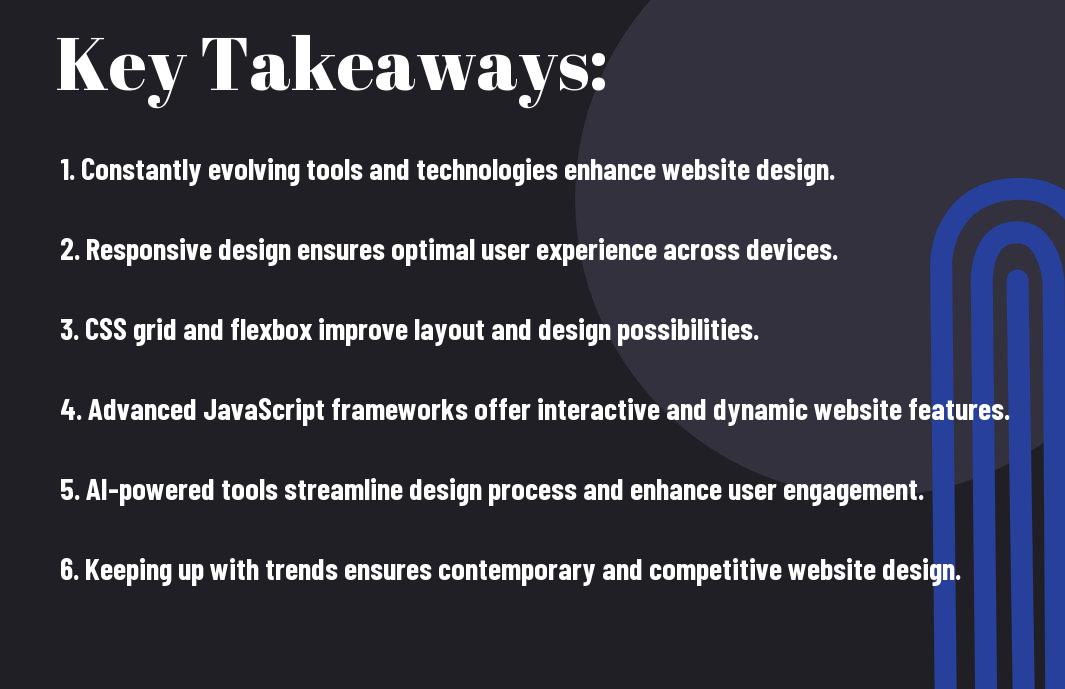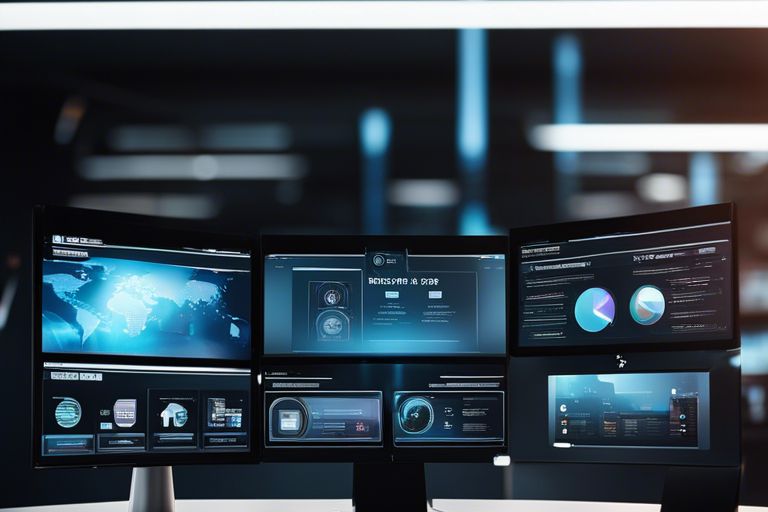Delve into the world of web design and uncover the latest tools and technologies that can take your website to the next level. As a web designer, it’s crucial for you to stay updated with the latest trends and innovations in the industry in order to create cutting-edge and visually appealing websites. From advanced design software to responsive frameworks, this blog post will guide you through the most important and powerful tools that can revolutionize your design process and enhance your online presence. With dangerous competitors and the constantly evolving digital landscape, equipping yourself with the latest technology is a must for success in the web design world. Let’s dive in and explore the endless possibilities of website design tools and technologies!
Key Takeaways:
- Responsive design is crucial for a successful website, and using tools like Flexbox and Grid can simplify the process of creating a responsive layout.
- Utilizing static site generators can improve website performance and security by pre-generating pages and reducing server load.
- AR and VR technologies are becoming more accessible for web design, offering immersive experiences to users and creating new opportunities for creativity.
- Integrating motion design into websites can enhance user engagement and storytelling, and tools like GreenSock and Webflow make it easier to implement dynamic animations.
- Keeping up with the latest web design trends and technological advancements is essential for staying competitive and delivering a modern, user-friendly experience to visitors.

User Interface (UI) Design Tools
Clearly, when it comes to website design, you want to make sure you are using the latest and greatest UI design tools available to create an engaging and user-friendly experience for your visitors. If you want to learn more about the latest trends and technologies in website design and development, you can check out this informative post on Exploring the Latest Trends and Technologies in Website Design and Development.
Vector Graphics Software
When it comes to creating stunning visuals for your website, using vector graphics software can make all the difference. These tools allow you to create scalable and high-resolution graphics that look great on any device, ensuring that your website maintains its professional appearance. Whether you are creating icons, logos, or illustrations, having the right vector graphics software in your toolkit is essential for creating a visually appealing website.
Prototyping and Wireframing Tools
Before you dive into the actual design of your website, it’s important to have a clear plan in place. This is where prototyping and wireframing tools come into play. These tools allow you to create visual representations of your website’s layout and functionality, providing you with a blueprint to follow as you build out your site. By using these tools, you can iron out any design and usability issues before they become a problem, ensuring that your website is user-friendly and intuitive.
User Experience (UX) Enhancements
Unlike in the past, user experience (UX) has become a critical factor in determining the success of a website. Your website not only needs to look visually appealing but also provide a seamless and intuitive experience for your visitors. With the latest website design tools and technologies, you can enhance the UX of your website to attract and retain users.
Interaction Design and Animation Tools
When it comes to enhancing the user experience on your website, the use of interaction design and animation tools can play a crucial role. These tools allow you to create engaging and interactive elements that capture the attention of your users. From subtle animations to interactive user interfaces, these tools can help you create a more immersive experience for your visitors, encouraging longer interactions and higher overall engagement with your website.
Usability Testing and Feedback Platforms
Usability testing and feedback platforms are essential for understanding how users interact with your website. These tools allow you to gather valuable insights into user behavior, preferences, and pain points. By implementing usability testing and feedback platforms, you can continuously improve the usability of your website, ensuring that it meets the needs and expectations of your visitors. Additionally, these platforms enable you to gather feedback directly from users, providing you with valuable information for making informed design decisions.

Web Development Technologies
Despite the ever-changing landscape of web development, it’s crucial to stay on top of the latest trends and technologies to ensure your website remains competitive. By keeping up with the latest web development trends, you can ensure that your website is both efficient and user-friendly. To help you stay informed, you can read more about the 11 Web Development Trends to Expect in 2023, According to Experts.
Frontend Frameworks and Libraries
When it comes to frontend development, the use of frameworks and libraries continues to be a popular choice. Tools like React, Angular, and Vue.js have revolutionized the way websites are built, offering a more efficient and dynamic user experience. By adopting these frontend technologies, you can create visually stunning and highly interactive websites that will impress your visitors.
Backend Development Trends
On the backend, serverless architecture has gained popularity, allowing developers to focus on writing code without the need to manage infrastructure. Additionally, the adoption of microservices and containerization has revolutionized the way backend systems are developed, offering greater flexibility and scalability. By leveraging these backend development trends, you can ensure your website is secure and efficient while handling a large volume of traffic.
Content Management Systems (CMS)
Not all websites are built the same way. Some are static and require manual updates to the code every time you want to make a change. This can be time-consuming and costly. Content Management Systems (CMS) were created to make it easier for you to manage your website’s content without needing to know how to code.
Traditional vs. Headless CMS
When it comes to choosing a CMS, you have two primary options: traditional and headless. Traditional CMS, such as WordPress, are all-in-one solutions that combine back-end content management with front-end website display. This can provide a user-friendly experience, but can also lead to limitations in terms of flexibility and scalability. On the other hand, headless CMS separates the back-end content management from the front-end presentation, allowing you to use your preferred front-end technology. This gives you more control over your website’s design and functionality, but could also require more technical expertise to set up and maintain.
Personalization and AI Integration
Personalization and AI integration are becoming increasingly important in website design. With the help of AI technology, you can analyze user behavior and preferences to deliver personalized content and recommendations, creating a more engaging and relevant experience for your visitors. This can ultimately lead to increased user satisfaction, higher conversion rates, and stronger customer loyalty. By integrating AI capabilities into your CMS, you can optimize your website’s performance and stay ahead of the competition in today’s digital landscape.
Optimizing for Performance and Accessibility
Keep your website at peak performance and ensure accessibility for all users with the latest tools and technologies. By optimizing for performance and accessibility, you can provide a seamless user experience and improve your website’s overall effectiveness. To learn more about the latest trends and technologies in web design, you can read this insightful article on Exploring the future of web design: predictions & opportunities.
Speed Testing and Optimization Tools
When it comes to optimizing your website for performance, there are a variety of speed testing and optimization tools available to help you achieve the best results. These tools can help you identify and resolve issues that may be impacting your website’s speed and performance. By utilizing tools such as Google PageSpeed Insights and GTmetrix, you can gain valuable insights into your website’s performance and make the necessary adjustments to improve loading times and overall user experience.
Tools for Ensuring Web Accessibility
Ensuring that your website is accessible to all users is a critical aspect of web design. There are several tools available that can help you evaluate and improve the accessibility of your website. Tools like WAVE and axe can assist you in identifying potential accessibility issues and provide guidance on how to address them. By prioritizing web accessibility, you can create a more inclusive online environment and reach a wider audience with your website.
Conclusion: Exploring the Latest Website Design Tools and Technologies
So now that you have explored the latest website design tools and technologies, it’s important to continuously stay updated with new advancements in the field. By utilizing these resources and implementing them in your designs, you can significantly enhance the user experience and overall functionality of your website. Remember to experiment with different tools to find what best suits your needs and to always keep an eye out for emerging technologies that could further elevate your web design capabilities. By staying informed and adaptable, you can ensure that your websites remain competitive and engaging for your audience.
FAQ
Q: What are the latest website design tools and technologies available?
A: The latest website design tools and technologies include Figma, Adobe XD, Sketch, and InVision for design, as well as HTML5, CSS3, JavaScript, and Bootstrap for development.
Q: How do I choose the right website design tools for my project?
A: When choosing website design tools, consider factors such as the nature of your project, your team’s expertise, and the specific features and functionalities required. It’s essential to evaluate the compatibility and scalability of the tools with your project goals.
Q: What are the benefits of using the latest website design tools and technologies?
A: The latest website design tools and technologies offer improved collaboration, seamless prototyping, responsive design capabilities, and enhanced user experience. They also enable efficient development and maintenance of websites, ultimately leading to better outcomes for businesses and users.
Q: How can I keep up with the constantly evolving landscape of website design tools and technologies?
A: To stay updated with the latest website design tools and technologies, subscribe to industry newsletters, attend webinars and conferences, join online communities, and follow reputable design and development blogs. It’s essential to continuously research and experiment with new tools to remain competitive in the digital landscape.
Q: Are there any considerations for integrating new website design tools and technologies into an existing project?
A: When integrating new website design tools and technologies into an existing project, consider factors such as compatibility with the current infrastructure, potential impact on performance, and the learning curve for your team. It’s essential to conduct thorough testing and training to ensure a smooth transition and optimal utilization of the new tools and technologies.
